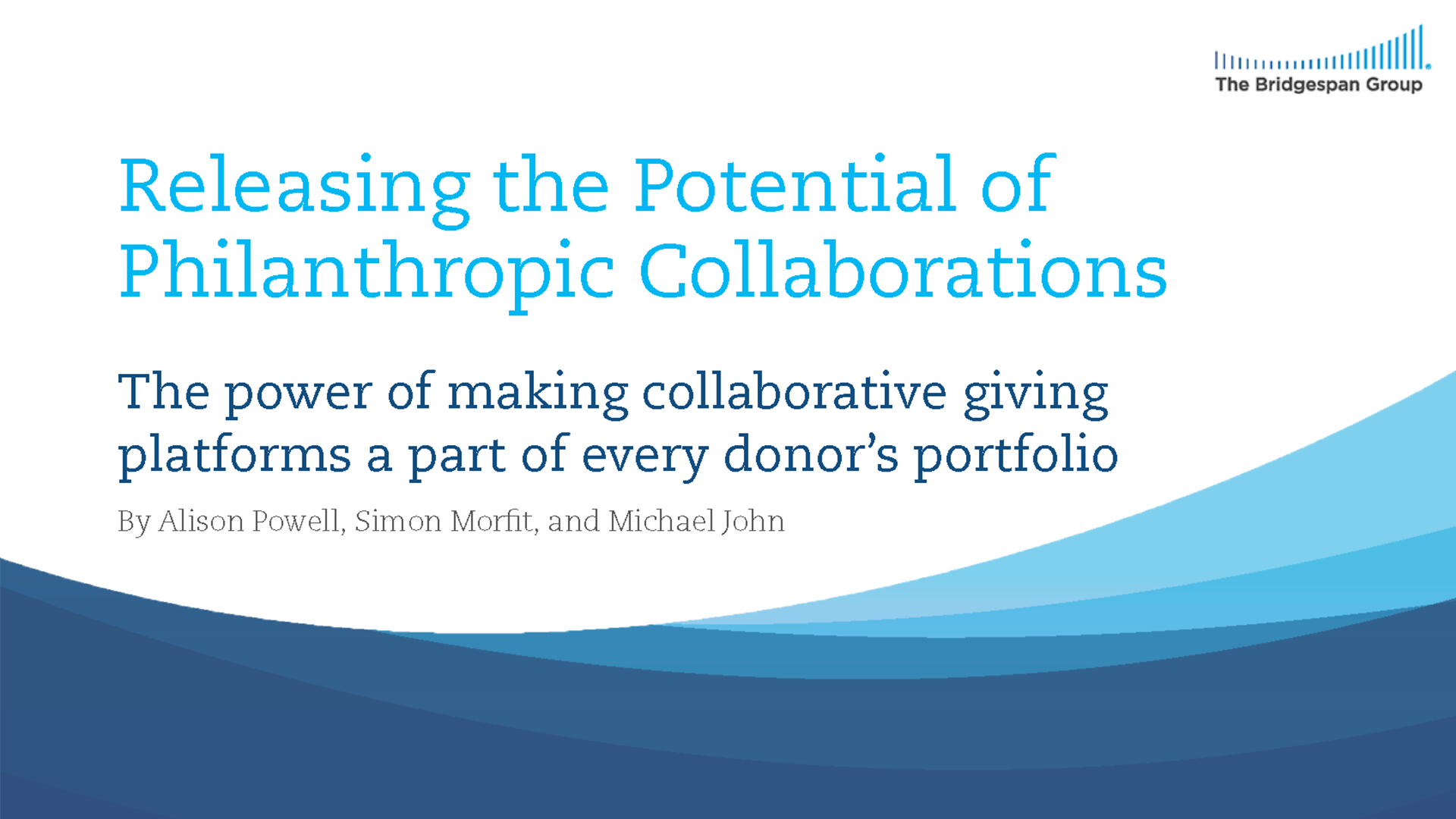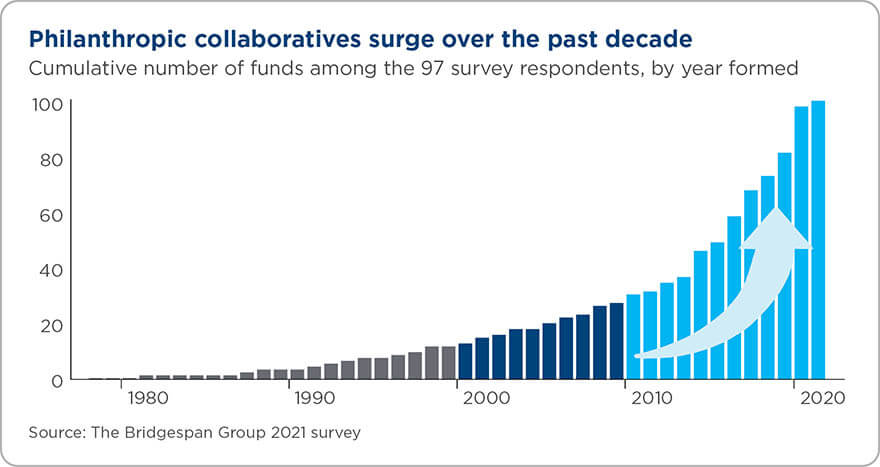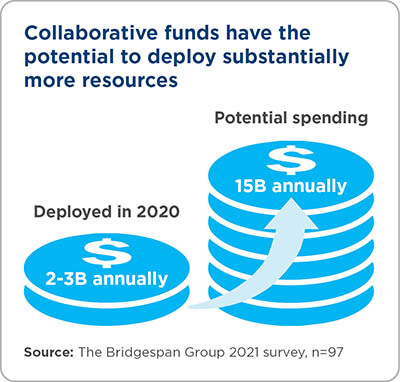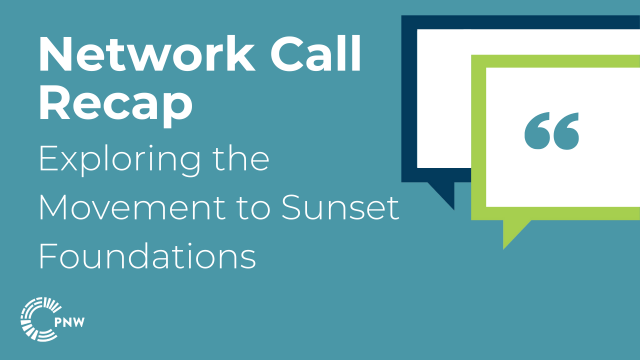
This article was originally published by The Bridgespan Group on December 14, 2021; Philanthropy Northwest has cross-posted an excerpt here with their permission. See the original piece and the full report here.
Philanthropic partnerships are having their day in the sun. Their impact could be even greater with a clearer path to investing in collaborative funds and a shift in donor mindsets.
Over the past decade, philanthropic collaboration has entered a new era of popularity and ambition. Driven by institutional and high-net-worth funders seeking greater impact by acting collectively and by fund leaders challenging traditional ways of working, the number of collaborative giving platforms has grown, as has annual giving. With over $2 billion flowing annually to collaboratives working on a range of social, economic and environmental issues — and that’s just from the funds who responded to our survey — it’s time to shed light on the changing landscape of these philanthropic partnerships.
Download the executive summary
Our goal with this research was to learn about the growing popularity of collaborative philanthropy, the reasons current donors find it attractive and the pathways to increased collaborative giving. What we found is that a significant number of collaboratives have charted a course that differs from traditional philanthropy: they tilt toward equity and justice, field and movement building, leaders of color and, for some, power sharing. And, perhaps most importantly, they’re capable of much, much more.
Peering Under the Hood of Collaborative Philanthropy
For more than a century, donors have pooled resources to create change through community foundations and organizations like the United Way and faith-based giving circles. In 2018 our research (in partnership with the Bill & Melinda Gates Foundation) uncovered a set of philanthropic collaboratives1 that were growing significantly. More recently, research on funder collaboration found that, when executed well, collaboratives can produce significant impact.2 Yet, there hasn’t been an examination of the momentum and scale of what has seemed to be a trend toward more collaborative giving platforms.
The Gates Foundation’s Philanthropic Partnerships team, which aims to increase the quality and quantity of philanthropy, funded a 2021 survey by our team at The Bridgespan Group to better understand how the landscape of collaboratives has evolved in the past decade. For the research, we defined these collaboratives broadly as entities that either pool or channel resources from multiple donors to nonprofits. (We call them “funds,” “collaboratives” and “platforms” in this report. They are not all pooled funds.) Ninety-seven initiatives responded out of nearly 200 contacted. (See “Research Background and Methodology.") We supplemented the survey with interviews and group discussions with roughly 100 donors and fund leaders.
The survey confirmed that the pace of establishing new collaboratives has shifted into high gear. Nearly three out of four respondents formed their collaboratives since 2010. More than half launched after 2015. And 16 survey respondents reported establishing their collaboratives in 2020, the highest number of organizations established in a single year. Said a senior advisor to an environmental funder about momentum in collaborative giving platforms, “I’ve never seen anything like this moment we are in.”
Based on what we’ve seen, we attribute the recent surge in part to wealth accumulation over the past decade coupled with increasing interest in new ways of giving. Many newly wealthy individuals and families have initiated philanthropic activities without first setting up foundations with large staffs. Philanthropic giving through collaboratives already primed for grantmaking enables this lean approach. Combining assets should also sound like a familiar tactic: donor collaboratives, in all their many forms, provide donors the same advantages that mutual funds, private equity and venture capital provide investors — portfolio diversification placed in the hands of specialists.
Such specialists — often with deep subject matter expertise and personal experience — lead collaboratives across a diverse array of organizations, including those set up to improve the lives of people in a particular location (e.g., The Southern Reconstruction Fund), those employing constituent-led decision making (e.g., Amazon Defenders Funds), efforts to galvanize and align philanthropic interests in specific topics or issues (e.g., Media Democracy Fund) and platforms to raise substantial sums of money to scale effective solutions (e.g., Blue Meridian Partners). Many of these funds weave distinctive combinations of those models.3
Since their founding, the funds surveyed have facilitated roughly $10-12 billion in investments. As a group, the respondents leading these collaboratives say they can do much more. The 97 respondents estimated their grantmaking totaled between $2 billion and $3 billion in 2020. On average, they made 44 grants a year, most less than $500,000. Collectively, they estimated that they could disburse up to $15 billion a year with minimal growth in current staffing.
The survey also revealed an increase in the number of collaboratives moving more than $50 million in a single year. Earlier research identified just eight such funds in 2018 compared to 18 in 2020.4 These big spenders accounted for more than 65 percent of all dollars distributed by survey respondents in 2020.
On the other end of the spectrum, 48 respondents gave less than $5 million in 2020. These funds typically target specific population segments (e.g., students, immigrants, women of color, Indigenous peoples), pursue constituent-led grantmaking (e.g., youth- or community‑directed organizations) or emphasize some dimension of equity (e.g., racial, gender, economic).
There's More...
The author's also cover the following topics in the comprehensive report:
- Resources on Collaborative Funds
- The Three Mindset Shifts that Could Unlock More Funding for Philanthropic Collaborations
- The Future of Collaborative Giving Platforms
Footnotes
1. Susan Wolf Ditkoff, Alison Powell, and Kyle Gardner, with Tom Tierney, “Four Pathways to Greater Giving,” The Bridgespan Group, November 2018.
2. Alison Powell, Susan Wolf Ditkoff, and Fay Twersky, “How Philanthropic Collaborations Succeed, and Why They Fail,” Stanford Social Innovation Review, July 10, 2019.
3. Some of the funds included in this report are current or prior Bridgespan Group clients, including The 1954 Project, Blue Meridian Partners, Co-Impact, TED’s The Audacious Project, Lever for Change, and Echoing Green.
4. Ditkoff, Powell, Gardner, and Tierney, op. cit.
About the authors: Alison Powell is a partner with The Bridgespan Group’s San Francisco office, where Simon Morfit is a manager. Michael John is an associate consultant in Bridgespan’s Boston office.




